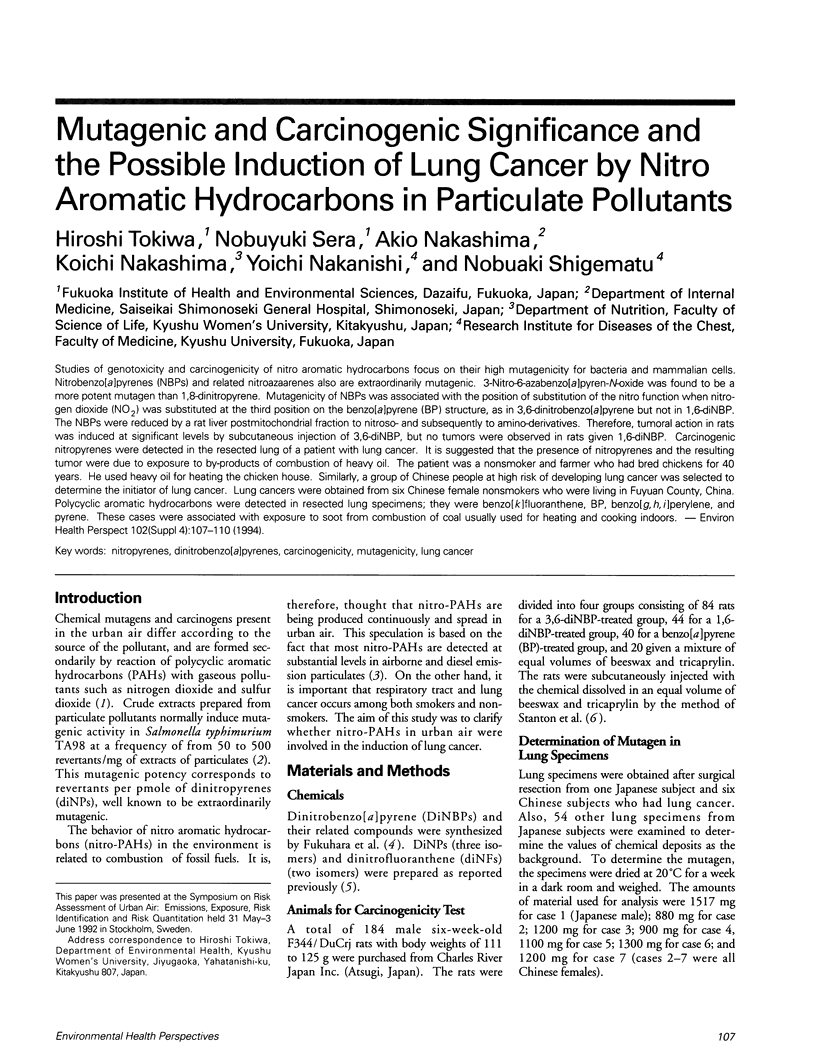Abstract
Studies of genotoxicity and carcinogenicity of nitro aromatic hydrocarbons focus on their high mutagenicity for bacteria and mammalian cells. Nitrobenzo[a]pyrenes (NBPs) and related nitroazaarenes also are extraordinarily mutagenic. 3-Nitro-6-azabenzo[a]pyren-N-oxide was found to be a more potent mutagen than 1,8-dinitropyrene. Mutagenicity of NBPs was associated with the position of substitution of the nitro function when nitrogen dioxide (NO2) was substituted at the third position on the benzo[a]pyrene (BP) structure, as in 3,6-dinitrobenzo[a]pyrene but not in 1,6-diNBP. The NBPs were reduced by a rat liver postmitochondrial fraction to nitroso- and subsequently to amino-derivatives. Therefore, tumoral action in rats was induced at significant levels by subcutaneous injection of 3,6-diNBP, but no tumors were observed in rats given 1,6-diNBP. Carcinogenic nitropyrenes were detected in the resected lung of a patient with lung cancer. It is suggested that the presence of nitropyrenes and the resulting tumor were due to exposure to by-products of combustion of heavy oil. The patient was a nonsmoker and farmer who had bred chickens for 40 years. He used heavy oil for heating the chicken house. Similarly, a group of Chinese people at high risk of developing lung cancer was selected to determine the initiator of lung cancer. Lung cancers were obtained from six Chinese female nonsmokers who were living in Fuyuan County, China. Polycyclic aromatic hydrocarbons were detected in resected lung specimens; they were benzo[k]fluoranthene, BP, benzo[g,h,i]perylene, and pyrene. These cases were associated with exposure to soot from combustion of coal usually used for heating and cooking indoors.
Full text
PDF



Selected References
These references are in PubMed. This may not be the complete list of references from this article.
- Djurić Z., Potter D. W., Heflich R. H., Beland F. A. Aerobic and anaerobic reduction of nitrated pyrenes in vitro. Chem Biol Interact. 1986 Oct 1;59(3):309–324. doi: 10.1016/s0009-2797(86)80076-x. [DOI] [PubMed] [Google Scholar]
- Fukuhara K., Hakura A., Sera N., Tokiwa H., Miyata N. 1- and 3-nitro-6-azabenzo[a]pyrenes and their N-oxides: highly mutagenic nitrated azaarenes. Chem Res Toxicol. 1992 Mar-Apr;5(2):149–153. doi: 10.1021/tx00026a001. [DOI] [PubMed] [Google Scholar]
- Nakagawa R., Horikawa K., Sera N., Kodera Y., Tokiwa H. Dinitrofluoranthene: induction, identification and gene mutation. Mutat Res. 1987 Jun;191(2):85–91. doi: 10.1016/0165-7992(87)90134-5. [DOI] [PubMed] [Google Scholar]
- Poirier L. A., Weisburger J. H. Enzymic reduction of carcinogenic aromatic nitro compounds by rat and mouse liver fractions. Biochem Pharmacol. 1974 Feb 1;23(3):661–669. doi: 10.1016/0006-2952(74)90631-5. [DOI] [PubMed] [Google Scholar]
- Rosenkranz H. S., McCoy E. C., Sanders D. R., Butler M., Kiriazides D. K., Mermelstein R. Nitropyrenes: isolation, identificaton, and reduction of mutagenic impurities in carbon black and toners. Science. 1980 Aug 29;209(4460):1039–1043. doi: 10.1126/science.6996095. [DOI] [PubMed] [Google Scholar]
- Rosenkranz H. S., Mermelstein R. Mutagenicity and genotoxicity of nitroarenes. All nitro-containing chemicals were not created equal. Mutat Res. 1983 Apr;114(3):217–267. doi: 10.1016/0165-1110(83)90034-9. [DOI] [PubMed] [Google Scholar]
- Sera N., Kai M., Horikawa K., Fukuhara K., Miyata N., Tokiwa H. Detection of 3,6-dinitrobenzo[a]pyrene in airborne particulates. Mutat Res. 1991 May;263(1):27–32. doi: 10.1016/0165-7992(91)90030-8. [DOI] [PubMed] [Google Scholar]
- Stanton M. F., Miller E., Wrench C., Blackwell R. Experimental induction of epidermoid carcinoma in the lungs of rats by cigarette smoke condensate. J Natl Cancer Inst. 1972 Sep;49(3):867–877. [PubMed] [Google Scholar]
- Tokiwa H., Kitamori S., Horikawa K., Nakagawa R. Some findings on mutagenicity in airborne particulate pollutants. Environ Mutagen. 1983;5(1):87–100. doi: 10.1002/em.2860050110. [DOI] [PubMed] [Google Scholar]
- Tokiwa H., Nakagawa R., Morita K., Ohnishi Y. Mutagenicity of nitro derivatives induced by exposure of aromatic compounds to nitrogen dioxide. Mutat Res. 1981 Aug;85(4):195–205. doi: 10.1016/0165-1161(81)90036-4. [DOI] [PubMed] [Google Scholar]
- Tokiwa H., Ohnishi Y. Mutagenicity and carcinogenicity of nitroarenes and their sources in the environment. Crit Rev Toxicol. 1986;17(1):23–60. doi: 10.3109/10408448609037070. [DOI] [PubMed] [Google Scholar]


